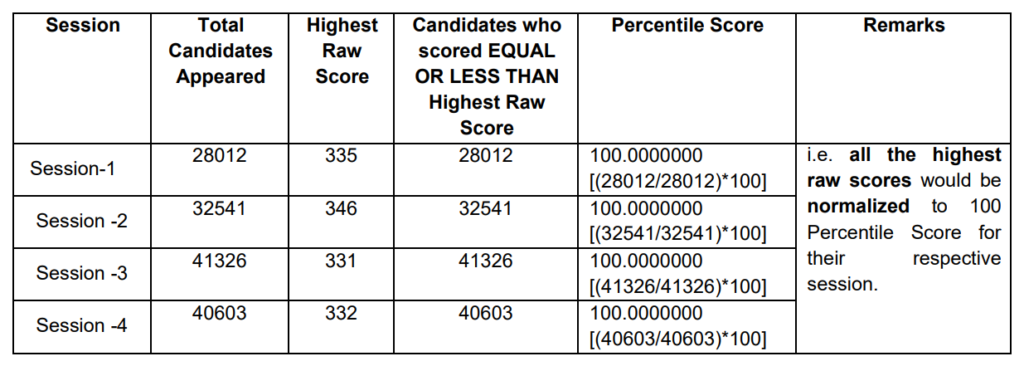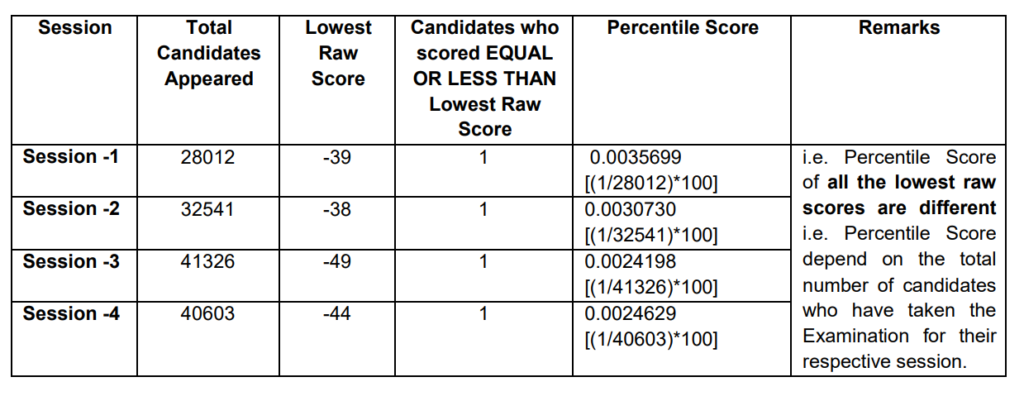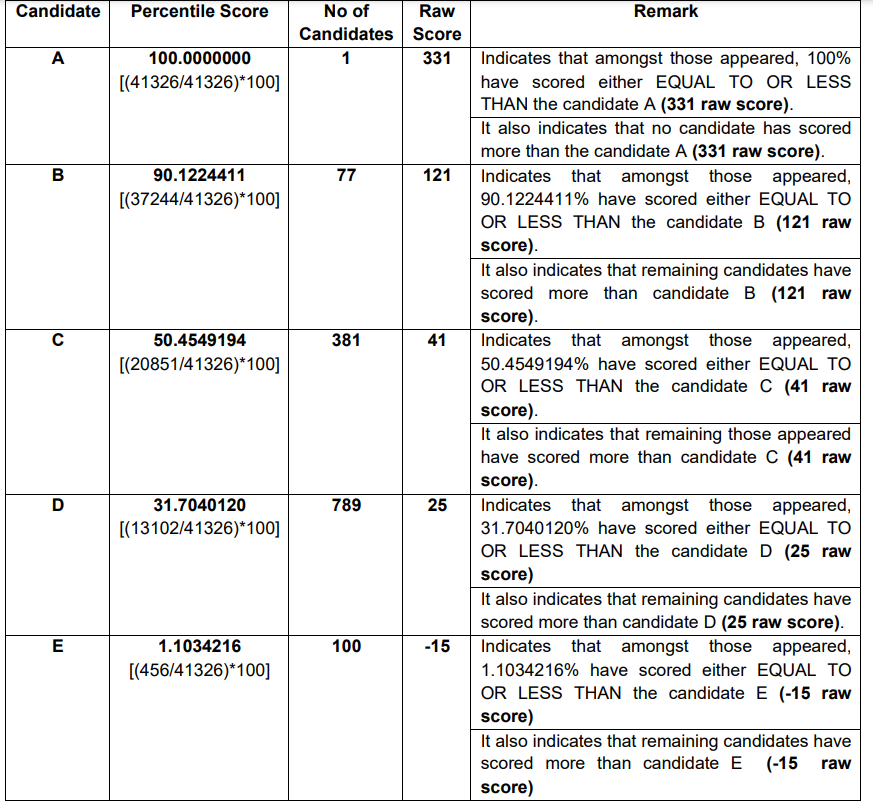Procedure to be adopted for compilation of NTA scores for multi session Papers
(Normalization procedure based on PERCENTILE SCORE) NTA may conduct examinations on multiple dates, generally in two sessions per day. The candidates
will be given different sets of questions per session and it is quite possible that in spite of all efforts of maintaining equivalence among various question papers, the difficulty level of these question papers administered in different sessions may not be exactly the same. Some of the candidates may end up attempting a relatively tougher set of questions when compared to other sets. The candidates who
attempt the comparatively tougher Examination are likely to get lower marks as compared to those who attempt the easier one. In order to overcome such a situation, “Normalization procedure based on Percentile Score” will be used for ensuring that candidates are neither benefitted nor disadvantaged due to the difficulty level of the examination. With the objective of ensuring that a candidate’s true merit is identified, and that a level playing field is created in the above context, the Normalization Procedure, set out below shall be adopted, for compiling the NTA scores for multi session papers.
The process of Normalization is an established practice for comparing candidate scores across multi session papers and is similar to those being adopted in other large educational selection tests conducted in India. For normalization across sections, NTA shall use the percentile equivalence.
Percentile Scores: Percentile scores are scores based on the relative performance of all those who appear for the examination. Basically the marks obtained are transformed into a scale ranging from 100 to 0 for each session of examinees.
The Percentile Score indicates the percentage of candidates that have scored EQUAL TO OR BELOW (same or lower raw scores) that particular Percentile in that examination. Therefore the topper (highest score) of each session will get the same Percentile of 100 which is desirable.
The marks obtained in between the highest and lowest scores are also converted to appropriate Percentiles.
The Percentile score will be the Normalized Score for the Examination (instead of the raw marks of the candidate) and shall be used for preparation of the merit lists.
The Percentile Scores will be calculated up to 7 decimal places to avoid bunching effect and reduce ties.
The Percentile score of a Candidate is calculated as follows:
100 X Number of candidates appeared with raw score EQUAL TO OR LESS than the candidate / Total number of the candidates appeared in the ‟Session‟
Note: The Percentile of the Total shall NOT be an aggregate or average of the Percentile of individual subject. Percentile score is not the same as percentage of marks obtained.
Example: Suppose a test was held in 4 sessions of examinees as per details given below: –
(Allocation of Days and shifts were done randomly)
(a) Distribution of candidates were as follows:
Session-1: Day-1 Shift-1, Session-2: Day-1 Shift-2, Session-3: Day-2 Shift-1 and Session-4: Day-2 Shift-2

In this method of scoring the HIGHEST RAW SCORE in each paper (irrespective of the raw scores) will be the 100 Percentile indicating that 100% of candidates have scores equal to or lesser than the highest scorer/ topper for that session.
Highest Raw Score and Percentile Score: All the highest raw scores will have normalized Percentile Score of 100 for their respective session.

Lowest Raw Score and Percentile Score: Percentile Score of all the lowest raw scores will depend on the total number of candidates who have taken the Examination for their respective session.

The following is a further explanation of the interpretation of the raw scores and Percentile Score in Session-3 (Day-2 and Shift-1) with 41326 candidates who have taken the examination.

The Percentile scores for the Total Raw Score for all the sessions (Session-1: Day-1 Shift-1, Session-2: Day-1 Shift-2) as calculated in Step-2 above would be merged and shall be called the NTA scores which will then be used for compilation of result and further processing for deciding the allocation.
In the events of the percentiles for the multi-shifts being dissimilar / unequal, the lowest will be the eligibility cut-off for that category for all candidates (i.e. all shifts).
For Example: In the Examination held in two shifts, if the 40% marks correspond to a Percentile score of 78 in Shift 1 and 79 in Shift 2, then all those equal to or above 78 percentiles (Percentile score of 100 to 78) in both shifts will become eligible in General Category. Similar method will be adopted for the other categories to determine eligibility cutoffs. In case the Examination is held in more number of shifts the same principle shall apply.





